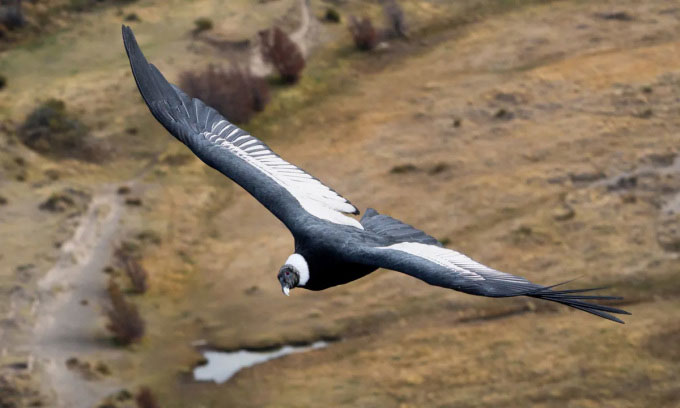Andean Condor - A bird that can fly for 5 hours without flapping its wings
Despite its massive body, the Andean condor holds the record for the longest flight thanks to air currents alone, without flapping its wings for five hours .
Birds can move in the sky without much movement by flying without flapping their wings. So which bird can maintain this state the longest? This title belongs to a large creature in the Andes : the Andean condor ( Vultur gryphus ) . They are really big, can weigh up to 15 kg and are the heaviest flying birds in the world.

Andean condors are "experts" in flying. (Photo: Lautaro Vidal).
Such a heavy creature may seem difficult to get into the air, but the Andean condor also has a wingspan of up to 3.2 meters . Their great weight is also part of the reason why they swing. With their massive bodies, flapping their wings a lot will cause them to consume a lot of energy. Instead , Andean condors utilize hot air currents to move through the air.
In a study published in the journal Proceedings of the National Academy of Sciences in 2020, a team of experts from Swansea University and Comahue National University presented the results of monitoring 8 Andean condors for 5 years. They fitted them with GPS devices and devices that recorded wing beats. From this data, they discovered that they only flap their wings 1% of their flight time. This means they have taken the title from the seagull Diomedea exulans , which spends 1.2% - 14.5% of its flight time slowly flapping its wings.
Similar to seagulls, most of the wing flapping time of Andean condors in the study occurred during takeoff, specifically more than 75%. The rest of the time, they avoid flapping their wings by making the most of wind and air currents. One of the studied birds even flew for 5 hours without flapping its wings, covering a distance of 172 km.
The weather does not seem to have much effect on the flapping of Andean condors' wings. " This shows that decisions about when and where to land are important, because not only will the Andean Condor need to take off again, but unnecessary landings will add significantly to the 'cost' of the flight. " ," explains Dr. Hannah Williams at Swansea University, study author.
It seems that it is not only older birds that make such decisions because all of the birds in the study were immature. " Our results demonstrate that even inexperienced birds can fly long distances over land without flapping their wings ," the team wrote.
- Birds flapping their wings produce electricity
- The most beautiful creature photos of the year
- Mosquitoes 'sing' to find a mate
- Discover the most bird-like fossil flying dinosaurs
- Secretly put the lyrics on the wings
- The robot flaps its wings like butterflies
- Which magic helped this bird float without flapping its wings?
- Beautiful photos of animals
- Robot reproduces the evolution of the organism's ability to fly
- South American bears hate being photographed
- Spring bird wings
- Discover new polychrome birds in Colombia
 Animal 'suffering' after hibernation
Animal 'suffering' after hibernation Why do goats climb well?
Why do goats climb well? Scientists were surprised to see chimpanzees eating turtles
Scientists were surprised to see chimpanzees eating turtles Giant catfish died deadly due to drought in Thailand
Giant catfish died deadly due to drought in Thailand The Mystery of Biology: Why Can't We Build Airplanes With Wings Like Dragonflies?
The Mystery of Biology: Why Can't We Build Airplanes With Wings Like Dragonflies?  China announced a bird-like drone
China announced a bird-like drone  How are butterflies and moths different?
How are butterflies and moths different?  Why are cicada's fragile wings a nightmare for all bacteria?
Why are cicada's fragile wings a nightmare for all bacteria?  Why can't sunlight burn butterfly wings?
Why can't sunlight burn butterfly wings?  The first robot bends its wings like a bird
The first robot bends its wings like a bird 